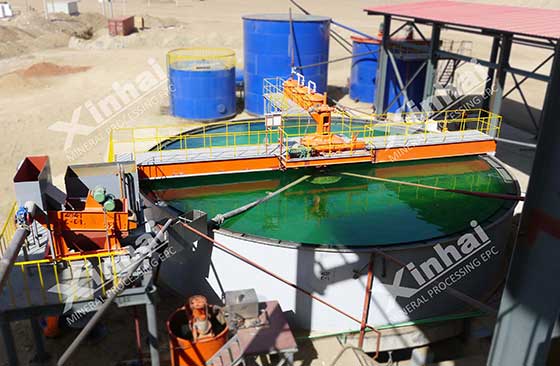
Graphite flakes, with their flaky structure and high carbon content, are the common and most commercially valuable form of graphite. It has good electrical conductivity, high thermal conductivity, low friction and chemical stability. These properties make flake graphite suitable for a wide range of applications, including batteries, lubricants, refractories, electronic components and pencil leads, among others. The flake size and thickness of graphite flakes depend on the specific deposit and processing method. A complete flake graphite ore beneficiation process usually includes multiple stages to achieve the desired quality and purity of the graphite concentrate.
Flake graphite ore is first crushed and ground for subsequent processing. Jaw crushers and cone crushers can be used in the crushing process. Jaw crushers are used to crush raw graphite flakes into fine particles. The cone crusher can further crush the coarsely crushed product to the size required for grinding. Ball mill or rod mill can be used in the grinding process.

The ground ore is mixed with water and flotation reagents including collectors and frothers. Then, the slurry is subjected to flotation treatment, and the air bubbles will attach to the graphite flakes, causing them to float up to form a foam layer. Foam layers containing graphite concentrates collect while remaining wall rock minerals sink. Commonly used flotation equipment are SF type, JJF type, KYF type, etc. These machines inject air and flotation reagent into water and grinding pulp to form foam. During flotation, a collector and a foaming agent need to be added to the pulp to promote the air foam to attach to the graphite particles.

The flotation concentrate, which contains graphite flakes and water, is dewatered to remove excess water and form a filter cake. Dehydration can be achieved by processes such as filtration or concentration. A concentrator is also needed in the dehydration process to remove excess water from the flotation concentrate to produce thick pulp or filter cake. After concentration, the pulp can enter the filter press to further remove the water in the concentrate. The press-filtered product can go into a dryer to remove the remaining moisture from the graphite concentrate.
Sometimes, an additional stage of flotation, known as froth washing, is performed to further increase the purity of the graphite concentrate. This involves refloating the rougher concentrate to remove any remaining impurities.

Depending on quality requirements, the flotation concentrate may require further concentration to increase the carbon content and remove impurities. This may include process methods such as acid leaching, heat sublimation (annealing) or chemical purification. This process may use pickling tanks, which are used for acid leaching to remove impurities from the graphite concentrate. When using the thermal sublimation process, an annealing furnace is required to increase the carbon content and crystal structure of the graphite. Chemical reactors are used in chemical purification processes such as acid treatment or chemical leaching.
The reconcentrated graphite concentrate may need to be screened and classified to separate it into different size fractions or to achieve a desired particle size distribution. Equipment that can be used in this process are vibrating screens, hydrocyclones and classifiers.

The above content is the flake graphite ore beneficiation process and the required equipment. In actual production, the specific beneficiation process and equipment used may vary depending on the characteristics of the flake graphite ore, the required product specifications and the available processing technology. Depending on the requirements of a particular industrial application, the parameters and techniques of the beneficiation process can be adjusted to optimize the recovery, purity and performance of the graphite concentrate. Xinhai Mining can provide you with graphite beneficiation test analysis, customized graphite beneficiation scheme and equipment, welcome to leave a message for consultation.
To find out more about our products and solutions, please fill out the form below and one of our experts will get back to you shortly.